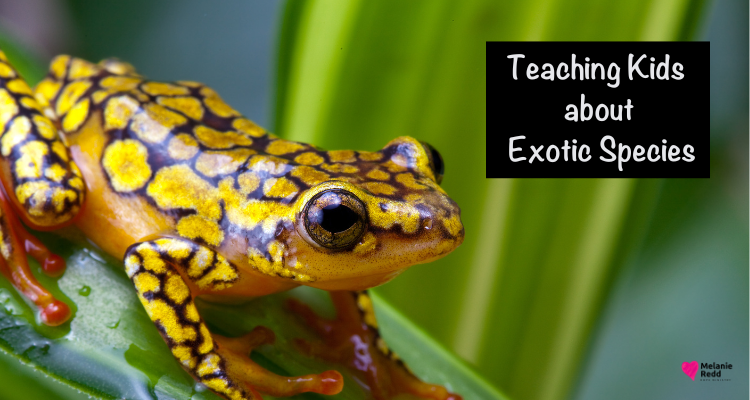Teaching Kids about Exotic Species

Exploring the Wonders of the World: How Teaching Kids about Exotic Species Fosters Environmental Awareness
In an increasingly interconnected world, fostering environmental awareness among children has never been more critical.
As stewards of the future, it’s essential to instill in them a deep appreciation for the natural world. Also, it gives them a sense of responsibility toward its preservation.
One powerful way to achieve this is by introducing children to exotic species of animals and their habitats from around the globe.
This article embarks on a journey through biodiversity.
Moreover, it explores how learning about exotic species enriches children’s environmental education and cultivates a sense of global stewardship.
Teaching Kids about Exotic Species: Diverse Ecosystems, Diverse Lessons
At the heart of teaching children about exotic species lies exploring diverse ecosystems spanning continents and climates.
From the lush rainforests of the Amazon to the icy expanses of the Arctic, each habitat harbors a unique array of plant and animal life.
By introducing children to these diverse ecosystems, educators and parents can open windows to other places. They can share about worlds they may never physically visit. This fosters curiosity and empathy for creatures living in distant lands.
Teaching Kids about Exotic Species: Cultivating Empathy and Curiosity
Studying exotic species allows children to develop empathy for animals beyond their familiar surroundings.
Indeed, learning about the challenges faced by endangered species like the Sumatran orangutan or the African elephant. Truly, these can inspire young minds to become advocates for wildlife conservation.
Moreover, exploring the remarkable adaptations of animals to their environments ignites curiosity. Even more, it gives a thirst for knowledge about the natural world’s wonders.
Global Stewardship and Responsibility
Teaching children about exotic species extends beyond mere fascination. It also instills a sense of global stewardship and responsibility.
As they learn about the interconnectedness of ecosystems and the impacts of human activities on biodiversity, children begin to recognize their role in shaping the future of our planet.
By fostering a sense of ownership over environmental issues, educators empower children to become agents of in their communities and beyond.
Compassionate Care for Captive Exotic Species
While exploring exotic species introduces children to the wonders of the natural world, it’s essential to also highlight the plight of animals unable to thrive in the wild. Many exotic species face threats such as habitat loss, poaching, and climate change, which disrupt their natural behaviors and endanger their survival.
For some individuals, captivity becomes their only refuge, whether in zoos, sanctuaries, or rehabilitation centers. Educating children about the importance of providing compassionate care for captive exotic species fosters empathy and understanding toward animals in human care. Zoological institutions play a crucial role in conservation efforts. They provide specialized care, breeding programs, and educational outreach to raise awareness about endangered species.
By visiting accredited zoos and wildlife sanctuaries, children can witness firsthand the dedication of caretakers and researchers working to ensure the welfare and well-being of exotic animals.
Moreover, discussions about captive exotic species offer opportunities to explore ethical considerations surrounding animal welfare. Also, children can discover conservation priorities and humans’ responsibilities towards the creatures in their care.
Encouraging children to critically evaluate the role of zoos and other facilities in wildlife conservation empowers them. They can learn to advocate for ethical and sustainable practices that prioritize the welfare and conservation of exotic species.
Practical Applications in Environmental Education
Incorporating lessons about exotic species into environmental education programs offers numerous practical benefits. By using real-life examples of animals and their habitats, educators can make abstract concepts such as adaptation, biodiversity, and ecological interdependence tangible and relatable to young learners.
Field trips to local zoos, botanical gardens, or nature reserves provide hands-on exploration and observation opportunities, reinforcing classroom learning with firsthand experiences.
Resources and Tools for Educators and Parents
A wealth of resources and tools are available for educators and parents seeking to integrate lessons about exotic species into their curriculum or homeschooling activities. Online platforms such as National Geographic Kids, BBC Earth, and Discovery Education offer educational videos, interactive games, and lesson plans tailored to different age groups and learning objectives. Books, documentaries, and virtual reality experiences can further enrich children’s understanding of exotic species and their habitats.
Encouraging Exploration and Discovery
Beyond structured learning environments, children can also explore exotic species through independent exploration and discovery. Nature walks, birdwatching outings and backyard wildlife observation sessions encourage children to develop their observational skills and connect with the natural world on a personal level. Encouraging them to keep nature journals, create art inspired by exotic animals, or participate in citizen science projects empowers children to become active participants in environmental conservation efforts.
Fostering Lifelong Connections to Nature
Teaching children about exotic species lays the foundation for lifelong connections to nature and a lifelong commitment to environmental stewardship. Educators and parents can inspire the next generation of conservationists, scientists, and global citizens by nurturing a sense of wonder, curiosity, and respect for the natural world. Together, we can empower children to embrace their role as custodians of Earth’s biodiversity and work towards a more sustainable and harmonious future for all living beings.
Every species plays a vital role, from the smallest insect to the largest mammal. By teaching children about exotic species and their habitats, we expand their horizons, ignite their curiosity, and instill in them a sense of wonder and responsibility for the world around them. Through education, exploration, and advocacy, we can nurture a generation of environmental stewards capable of safeguarding the rich tapestry of life for generations to come.
Were you encouraged by what you read?
Then, would you share this article with a friend, co-worker, or family member?
Or, maybe you can send it to a friend or family member?
This blog occasionally uses affiliate links and may contain affiliate links.
Additionally, Melanie Redd is a participant in the Amazon Services LLC Associates Program.
This is an affiliate advertising program designed to provide a means for sites to earn advertising fees. These are earned by advertising and linking to amazon.com.
Also, for more on my disclosure policy, click HERE.
© Melanie Redd and Hope Ministry, 2024. Unauthorized use and/or duplication of this material without express and written permission from this blog’s author and/or owner is strictly prohibited.
Further, excerpts and links may be used, provided that full and clear credit is given to Melanie Redd and Hope Ministry.
Please give appropriate and specific directions to the original content.



0 Comments